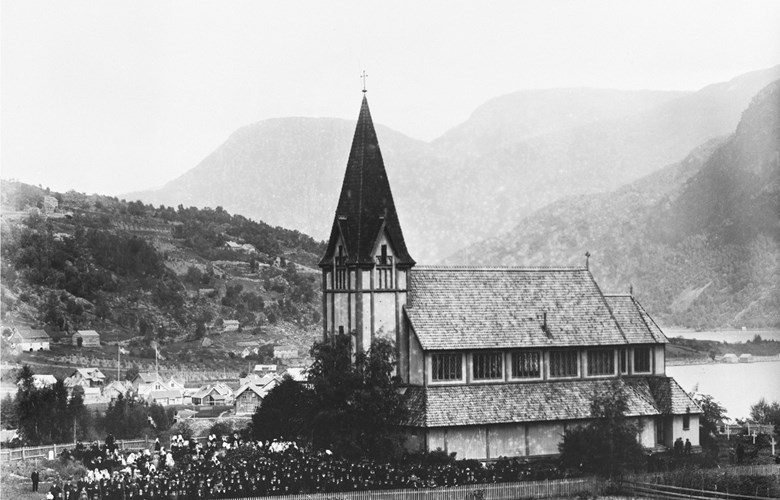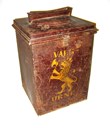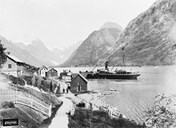The municipality of Sogndal in 1905
In 1905, the municipality of Sogndal comprised the "sokns" (sub-parishes) of Stedje, Norum, and Kaupanger. The Fjærland ¿sokn" belonged to Balestrand, and the farm Tingastad on the south side of the Sogndal peninsula belonged to the Fresvik "sokn" in Leikanger.
In 1900, the population numbered 3479, with 2067 in the main "sokn", 884 in Norum and 528 in Kaupanger. In addition came Fjærland "sokn", then in Balestrand, with 757 inhabitants.
The most important industry was agriculture, with the production of ¿gamalost" (traditional Norwegian low-fat cheese). Fruit-growing was important, especially in the Norum and Stedje ¿sokns". At Foss in Sogndal, there was a woollen mill and dye-works (¿Sogns Uldspinderi og Farveri"). There was a savings bank (¿Sogndal Sparebank"), established in 1841 as the first of its kind in Sogn. There were hotels: in Fjærland Mundal Hotel, in the centre of Sogndal Danielsens Hotel and at Stedje ¿Frk. Lems Hotel", five post offices (Slinde, Fardal, Kaupanger, Sogndal og Fjærland) as well as three long-distance telephone exchanges (Amla, Sogndalsfjøra and Norum).
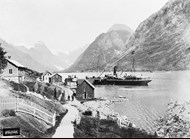
¿Fylkesbaatane" (the local steamship company) had stops at Slinde, Fardal, Sogndal, Jordal, Fjærland and Amla. The main road from the centre of Sogndal (Sogndalsfjøra) to Hafslo had recently been moved from "Gildreskreda" to the other side of the river. There were also some other minor rural roads. At Loftesnes a ferryman, employed by the local council, transported people and cattle across the narrow strait.
¿Sogndal Folkehøgskule" - Helgheim - rounded off its winter course on 4 April with a party. Among the speakers was teacher and editor Jens Kvåle who "maintained that school and knowledge should strengthen the national growth to make us a strong people".
"In excited anticipation"
At a time without mobile phones, internet, radio and TV, people heard news in other ways. They ¿asked for news" whenever and wherever they met - by the quayside, in the shop, at school, at church (announcements from the church door), as well as through letters and newspapers. ¿Sogns Tidende" was published in Sogndal from 1903, owned and operated by Jens Kvåle. In a statement in one of the first newspapers printed, it was evident that the paper was meant to be an advocate for the dissolution of the union with Sweden.
Throughout 1905, people waited anxiously for the latest news concerning the union between Norway and Sweden, on the development of the so-called consulate issue (Norway wanted to have a separate consular service), on the dissolution of the union on 7 June, on the referendum on 13 August, the negotiations in Karlstad, Sweden, the question of monarchy or republic, and the new royal family in November/December. A man from Fresvik wrote in a letter to America that people more than once stood waiting "in excited anticipation by the quayside every time the local steamer docked, carrying post to the village". War was imminent, which can be seen from this short recollection from a person from Fjærland:
"In 1905, I remember that a group of young people sat talking about the danger of war breaking out, and that they would have to go. One of them then said: ¿I am sure that I am one of the first to be shot, because I am so tall, and I am not very good at hiding myself."
Other issues and events apart from the dissolution of the union
The dissolution of the union was the main issue throughout 1905, but there were also other issues that caught the attention of people. The language issue - the work to make the ¿nynorsk" variant more used - was an issue that many people were keenly committed to. The extension of the railway line to Sogn was another question. The Bergen Railway Line was under construction, and, in 1905, the first train passed through the Gravhals tunnel at Myrdal. The question of a side track down to Flåm was much debated. Another important issue was the health service and the building of hospitals.
The newspapers all the time covered small and big events around the county, in the country as a whole, and abroad.
The introduction of the Blix hymns caused much controversy in the "sokns", with open meetings, discussions and voting in the churches. In Fjærland there was even a second round of voting. In Sogndal money was raised to buy a new church organ.
The Loen disaster in Nordfjord on the eve of 17 January, when a huge rock slide into the Lovatnet lake wrecked many farms and took the lives of 61 persons, made a deep impression. All over the country money was raised to support those who survived the catastrophe, and the churches organized offerings.
Some key persons
There was a municipal election in 1904, and the farmer Ivar Gurvin was elected mayor. Ove Guldberg Arctander was vicar. Nils Landmark Lem was bailiff and he was also co-owner of the woolen mill and dye-works "Sogns Uldspinderi og Farveri". Farmer Skak Lystrup Ormelseng, former mayor, was 4th deputy parliamentary representative for the "Nordre Bergenhus amt" (the present-day county of Sogn og Fjordane) 1903-1906. Jens Kvåle was deputy mayor, editor of "Sogns Tidende" (published in Sogndal), teacher at "Sogndal Folkehøgskule" and liberal politician. His teacher colleague Vilhelm Flugheim was an ardent spokesman for the "nynorsk" movement, local historian, liberal politician, and republican (he signed an appeal against the monarchy). At that time, Gert Falch Heiberg in Amla built the first museum building on his property, what later was to become ¿De Heibergske Samlingar - Sogn Folkemuseum".
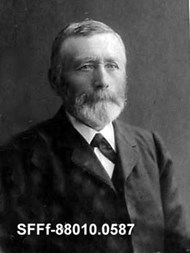
The county veterinarian Jonas S. Mossige lived in Sogndal, as did the county gardener Jon Valset.
Associations and organizations
In 1905, Sogndal had one political party association (the liberal "Venstre") and four youth organizations (one in Sogndal, one at Kaupanger, and two in Fjærland), one chorus recruited among members in the Sogndal youth association, as well as an active language organization which resumed the work of introducing the so-called Blix hymns. Other associations in Sogndal included a ski club established in 1895 and an association of nurses called ¿Sogndal Sjukepleiarforening" (later to become ¿Sogndal Helselag" - a health association). One workers¿ association had meetings with lectures ¿given outside political and religious differences". It also raised money to help members pay for visits to doctors or for medicine. In 1905, this association had 32 members, most likely workers at the woollen mill. There were also a number of associations and organizations such as various friends of mission associations, temperance organizations, as well as clubs for children.
When the union issue was at its hottest, many rifle clubs were established throughout the country. In 1905, we know about four of these clubs in Sogndal, Middalen, Loftesnes, Barsnes, and one in Fjærland, but the number was probably higher.
17 May, 1905
There was a massive turnout on 17 May, 1905.
In Sogndal the "people¿s procession" started from the municipal administration building and marched up to "Prestadalen" where the principal of the "Folkehøgskulen" gave the main speech for the National Day / Constitution Day, and Jens Kvåle spoke about the ¿Stortinget". In the evening there were parties and celebrations many places in Sogndal; for the primary school at Trudvang, for the "folkehøgskulen" at Helgheim, in the vicarage for the religious youth association, in the municipal administration building for the civic youth association, and in the house of shopkeeper Ølnes at ¿Fjøra" (the centre of Sogndal) there was a party for the local liberal party, the language association, and the workers¿ association.
At Kaupanger 17 May was celebrated for the third time. People gathered at the new steamer quay where the teacher V. Flugeim and Jørgen Holen both gave speeches for the National Day / Constitution Day. People then marched in a procession up to the school building where there were parties and celebrations in the evening with games for children, serving of food, and there was singing and recitations, a tableau performance with girls dressed in national costumes, folk songs, and speeches for the flag and the youth.
7 June, 1905
7 June, 1905, the very day when the union was dissolved, was an ordinary working day, but people all around the country waited in excited anticipation for the latest news from the capital and the Norwegian Parliament, Stortinget. As the news spread, people hoisted flags, and in some places telegrams were sent to the authorities to show their appreciation. Stortinget issued a proclamation on the dissolution of the union. The Ministry of Church Affairs sent an appeal to the vicars, asking them to read an announcement in the churches on the following Sunday - Whit Sunday - on 11 June, or later.
On Whit Sunday, the vicar Arctander read the ¿Announcement from the Norwegian Storting to the Norwegian People" from the pulpit of Stedje church. Afterwords he wrote in the church record: ¿Reading of the proclamation by the Storting to the Norwegian people on the new government."
On 13 June, 1905, a telegram was sent to the government and the Storting: "The local council of Sogndal and a high number of the people in the village, gathered today for a meeting, send our respects to the government and Storting, expressing our sincere hope and firm belief that the steps taken will bring about prosperity and happiness for our country and people. (Signed) Gurvin, mayor. Arctander, vicar. Lem, bailiff."
The referendums - the right to vote and election committees
There were two referendums in 1905:
1) Sunday 13 August, when people were asked to say ¿yes¿ or ¿no¿ to the dissolution that had been resolved by the Storting on 7 June.
2) Sunday 12 and Monday 13 November, when people were asked to vote ¿yes¿ or ¿no¿ to whether the Storting should choose a king. In reality, this was a choice between monarchy and republic.
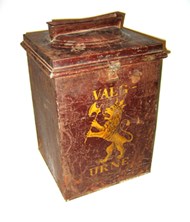
Sogndal election district coincided with the municipality borders of Sogndal. The election committee for Stedje ¿sokn" consisted of: bailiff Lem (chairman), Nils T. Aaberge, Andreas K. Tylden, Jens Kvåle and Ingebrigt L. Ølnes, for Kaupanger ¿sokn": N. Knagenhjelm, Erik O. Bjørk, and Ivar Gurvin, and for ¿Norum": Anders L. Slinde, Elling N. Fimreite and Jens J. Ylvisager. For Fjærland "sokn", then part of Balestrand: Johannes Mundal and S. Bjaastad.
The churches served as polling stations at both referendums. The counting of votes for Stedje ¿sokn" took place at Stedje church.
The August referendum - yes or no to the dissolution of the union
One person who was present at the referendum in Fjærland on 13 August sent this report to the newspaper ¿Sogningen" about the event:
¿Fjærland has hardly ever experienced a day of more historical importance. Young and old, Norwegians and foreigners alike took part in our ¿yes-procession". (..) Everybody was in a festive mood. The church bells summoned people to the church, - shots were fired in the air to mark the 7 June, and flags waved over a small, but free people." At the hotel the cantor Dahle gave a short speech, and then they continued up to the church where Ola Lidal gave a short prayer and the national hymn was sung. "The entrance to the polling station was arranged in such a way that is was hard for a "no" to enter. (A certain painter Johannesen and his German wife had problems getting in). Then came the highlight: A resounding ¿yes" that will never be forgotten. In the evening we and the English held singing competitions. Bonfires were lit on the fjord. We did not stop celebrating the 13th until the wee hours of the 14th."
The result for the Sogndal election district: of the 706 who had the right to vote, 677 turned out to vote. Of these 672 were accepted, 670 voted yes, two voted no. Unfortunately we do not have the result for Fjærland. Sogndal actually had two out of three ¿no-votes" in the whole county. The turnout was 95.9%. In the neighbouring municipality of Leikanger it was 96% and in the county as a whole 88.7.
Private petition campaign by women
Women did not have the right to vote in national elections in 1905, but they wanted to be allowed to say ¿yes¿ along with men. Several women¿s organizations joined their efforts in organizing a countrywide petition campaign, and on 22 August, they delivered some 250 000 signatures to the Storting.
The petition campaign was organized in various ways, but it had to happen quickly. The newspaper ¿Sogns Tidende" issue from 9 August writes that it has received a list from "Landskvindestemmerettsforeningen" (an association for women in rural areas), but adds that women in Sogndal ¿have taken the initiative to start their own campaign and that it was working well and fast." We have a copy of the Kaupanger list, and the first person to sign was Mrs Magda Knagenhjelm and then other women in her home/household. On the list we find the names of women from all walks of life and social status.
The November referendum - monarchy or republic
The result for the referendum in November for the Sogndal election district: Of 717 with the right to vote, 614 turned out. This gives a turnout of 85.6. three votes were discarded. 463 voted ¿yes¿ (for monarchy), 148 voted ¿no¿ (for republic). Unfortunately we do not have the numbers for Fjærland.
Before the November referendum there were active election campaigns from either side. In Sogndal, the county governor Utheim, who was a staunch republican, gave a lecture. After this lecture Jens Kvåle wrote in ¿Sogns Tidende": ¿those who after this lecture can bring themselves to vote ¿yes¿ must indeed be rather strange people."
The newspaper "Sogningen" was a right-wing paper in favour of monarchy. Bailiff Lem was a supporter of the monarchy and wrote in the paper about its advantages. ¿We all know what dangerous situation we experienced this summer. Now those people who cannot be happy without strife and unrest, seek to mislead the people to throw the country into unsafe relations and conditions, and no-one can foresee the consequence of this."
The new royal family
On 18 November, the Storting chose Prince Carl of Denmark as King of Norway. He was married to Princess Maud from England, and they had a son named Alexander. Prince Carl took the name Haakon VII and the son Alexander got the new name Olav. The new royal family came to Kristiania (Oslo) on the Norwegian naval vessel "Heimdal" in the evening of 25 November, where they were met by a huge and festive crowd.
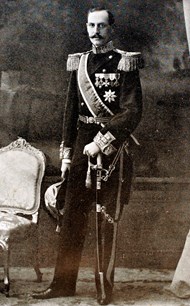
Many telegrams were sent from all over the country. At the meeting of the local council in Sogndal on 20 November, the mayor Gurvin gave a speech for the mother country and the new Norwegian king. The representatives rose to their feet and gave a resounding three cheers for the king. The council decided to send a telegram to the royal couple on the day that they arrived in the capital.
"Celebration to mark the end of the liberation efforts"
In many places throughout the country festivities were organized in December to mark the eventful year of 1905.
In Sogndal there was a thanksgiving service at Stedje church in the morning of 7 December and a similar one in Kaupanger in the afternoon. In spite of extremely bad weather, many people turned up, and flags were hoisted as so many times before that year. The church was decorated with pine branches and small flags. Vicar Arctander¿s sermon was based on the text from the 118th chapter in the Book of Psalms, and, in addition to other hymns, the congregation sang this stanza of the national anthem "Norske mand i hus og hytte, takk din store Gud!" and the national hymn: "Gud signe vårt dyre fedraland!"

